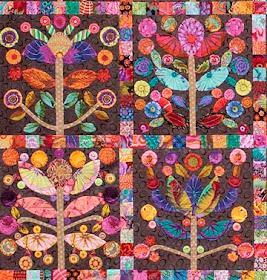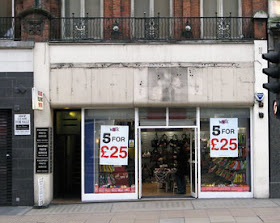Seaweed by J.H. Dearle
from the Morris Apprentice collection from Moda
The Morris Apprentice is a new reproduction William Morris collection that celebrates the master's apprentice John
Henry Dearle.
In the late 1870s the 18-year-old art
student was hired as a showroom assistant. Twenty
years later he was Head Designer putting his own stamp on Morris style.
The prints reflect Dearle's new directions. He added color and line from art nouveau in designs like "Artichoke."
And devised pattern repeat with
eastern influence in the more formal "Eden." Dearle became Art Director
in 1896 after Morris's death, guiding Morris and Company into the twentieth
century.
Pictures of Dearle are rare.
Here is a digitally enhanced photo.
The original I believe is in the Huntington Library collection.
Morris and Company designed a wide range of arts and crafts,
including hand-knotted carpets, woven tapestries, wallpapers, printed fabrics, embroideries
and stained glass windows. Henry Dearle (1859-1932) was instrumental in many of
these designs.
William Morris has often been credited with the design for Seaweed,
even though it dates to five years after his death.
This 2012 British stamp celebrating the firm's anniversary
gives Dearle the proper credit.
Dearle was always secondary to Morris in the public eye. Although
he did much of the design work for Morris and Company, he's received less credit
than he deserved---or perhaps wanted. His designs were often attributed to
Morris, even after Morris's death.
His modesty makes a biography beyond the bare bones difficult.
John Henry Dearle was apparently born in London to William Dearle (1832-?) and
Louisa Dearle on August 22, 1860, baptized
in St. Pancras Church on the Euston Road.
St. Pancras Church looks much the
same today as it did in 1860.
Dearle's father was listed as an
artist, a mechanical draughtsman, in the 1881 British census. Henry, the second
son, studied at the West London School
of Art and began working at Morris & Company, first in
the glass painting department and then as a tapestry weaver.
Dearle worked in the weaving workshop at Merton Abbey
John William Mackail's The
Life of William Morris in the 1911 edition contained an
addendum (presumably written by Dearle) stating that
"Mr. J. H. Dearle entered the service of the firm very
young from a post in an insurance office for the sake of more congenial work.
He was employed for several years in the glass-painting shop, and was picked
out by Morris to help him in rediscovering the lost art of high warp tapestry,
and restoring it to practice. Later he was the chief designer (under Morris)
and manager of the Merton Abbey works, and became a partner in the firm in
1894."
At 27 he began designing tapestries. In the 1880s William
Morris's interest lay in politics and printing books so the young man took over more
and more of the designing. Morris died in 1896 and Dearle became Art Director.
The Tate Britain in London has an exhibit
with two of the Holy Grail series of tapestries that
were collaborations between Dearle,
William Morris and Edward Burne-Jones.
In 1908 International Studio, a design magazine,
explained the shared work on the woven tapestries that Morris and Company is famous for. Edward Burne-Jones drew the
figures; "the accessories being arranged, at first by Morris himself,
subsequently by his gifted pupil. Mr. J. H. Dearle." An example given: an
1885 Floral panel for which Morris did the human figures. "For the present scheme of colouring and
background of flowering plants Mr. Dearle is responsible."
Detail of the flowers in the Holy Grail, Dearle's design,
the "accessories"
In the 1908 issue of International Studio
the Angeli Ministrantes tapestry from 1894 is captioned
"Designed by J.H. Dearle. Figures by E Burne-Jones"
Another version.
Burne-Jones often gets full credit today.
Edward Burne-Jones & William Morris 1890
After their deaths in the late 1890s
Morris and Company continued for almost fifty years.
Dearle married, possibly to Kezia E. Dearle in 1883, and there is a record
of one son, Duncan William Dearle, born February 21, 1893 in Upper Tooting, Graveney,
Wandsworth, Surrey. Henry and Duncan collaborated on stained glass windows in
the early twentieth century, carrying on the tradition of Edward Burne-Jones, the major glass designer at Morris from 1861 to his death in 1898.
The theme of the Winnicott Memorial Window is literature.
Notice the characteristic florals in the side borders
One Dearle window recently restored is the Lady Winnicott
Memorial Window at Plymouth Central Library which was dedicated in 1927 at
Plymouth in Devon. During World War II the library was destroyed by German
bombers but the stained glass had been removed and stored. The library was
rebuilt; the windows reinstalled in 1955.
See the Morris Workshop's tapestries in the Tate Britain exhibit Pre-Raphaelites: Victorian Avant-Garde, which will be up until
January 13, 2013.
Read in this Google Preview of Art, Enterprise and Ethics: The Life and Work of William Morris, a memoir of the Morris Company by George Wardle:
Dearle replied to that memoir with a one-paragraph autobiography: "Mr. Wardle, writing many years afterwards, has fallen into a good deal of confusion from imperfect memory...." See it as almost a footnote on page 47 of the 1911 edition of Mackail's The Life of William Morris, Volume 2.
Tulip from the Morris Apprentice collection
echoes the tapestry "accessories".

























































